October 26, 2017

If any sector of the economy could be identified as a poster child of disaster knowledge, it would be agriculture. In unforgiving climates such as that of Kansas, droughts, floods, wildfires, tornadoes, horrific straight-line winds, hail, blistering heat and untimely cold are not once-in-a-decade events. One or more is a monthly occurrence.
Kansas farmers know all about picking up the pieces and starting over. And that’s one of the reasons they know that strong federal support in the aftermath of disaster is vital to the survival of not only the industry and the economy, but also to the survival of people willing to take the chance in the first place.
This year has been one of the worst in recent memory for natural disaster. Kansas had its turn early in the year with the massive Starbuck wildfire, which burned more than 500,000 acres; killed thousands of cattle; destroyed untold miles of fence; wiped out homes, barns, hay sheds and hay supplies; and left Clark and Comanche counties with big challenges to their volunteer fire departments.
It is worth mentioning that as the Starbuck fire raged and garnered the majority of attention, no fewer than 19 Kansas counties were also battling fires that same week. The total land mass of Kansas charred over that week totaled almost 700,000 acres.
The state has been limping through three years of economic downturn with a rare tank of prices for grain, oil and gas and cattle simultaneously. One of the reasons that farmers are harvesting crops and planting wheat and cover crops this fall is that they have been supported by crop insurance. They've also been able to access help from farm bill programs such as Livestock Indemnity Program and the Environment Quality Incentives Program to soften the blow of cattle losses and help with rebuilding infrastructure.
As Congress works on the 2018 Farm Bill, the tragedies of this year remind us that one of the most important things that government can do is provide for people in the worst of times — the times when nature slams us to the ground through no fault of our own.
For the urban population that gets a paycheck regularly, even if it doesn’t rain enough or rains too much, the money to protect farmers from the worst blows nature can deal seems like a “giveaway.” The tendency we have is to provide the most help to the areas where the most people live — forgetting that restoring the ability of people to resume their livelihoods in rural areas is vital.
One message that we can always share with our urban neighbors is this: The food on the shelves in your grocery stores is the fruits of our labor. If we go under, your shelves go bare. That should help make them understand that the subsidies that help farmers afford to insure their crops and plant again really are worth keeping.
You May Also Like




